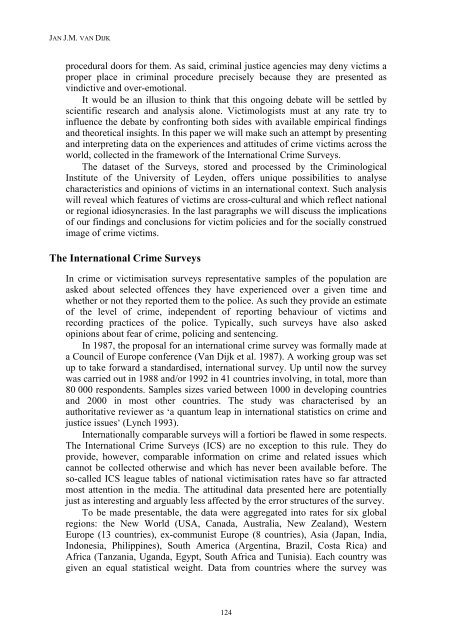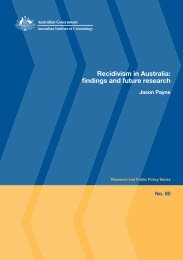Crime and victim surveys - Australian Institute of Criminology
Crime and victim surveys - Australian Institute of Criminology
Crime and victim surveys - Australian Institute of Criminology
You also want an ePaper? Increase the reach of your titles
YUMPU automatically turns print PDFs into web optimized ePapers that Google loves.
JAN J.M. VAN DIJK<br />
procedural doors for them. As said, criminal justice agencies may deny <strong>victim</strong>s a<br />
proper place in criminal procedure precisely because they are presented as<br />
vindictive <strong>and</strong> over-emotional.<br />
It would be an illusion to think that this ongoing debate will be settled by<br />
scientific research <strong>and</strong> analysis alone. Victimologists must at any rate try to<br />
influence the debate by confronting both sides with available empirical findings<br />
<strong>and</strong> theoretical insights. In this paper we will make such an attempt by presenting<br />
<strong>and</strong> interpreting data on the experiences <strong>and</strong> attitudes <strong>of</strong> crime <strong>victim</strong>s across the<br />
world, collected in the framework <strong>of</strong> the International <strong>Crime</strong> Surveys.<br />
The dataset <strong>of</strong> the Surveys, stored <strong>and</strong> processed by the Criminological<br />
<strong>Institute</strong> <strong>of</strong> the University <strong>of</strong> Leyden, <strong>of</strong>fers unique possibilities to analyse<br />
characteristics <strong>and</strong> opinions <strong>of</strong> <strong>victim</strong>s in an international context. Such analysis<br />
will reveal which features <strong>of</strong> <strong>victim</strong>s are cross-cultural <strong>and</strong> which reflect national<br />
or regional idiosyncrasies. In the last paragraphs we will discuss the implications<br />
<strong>of</strong> our findings <strong>and</strong> conclusions for <strong>victim</strong> policies <strong>and</strong> for the socially construed<br />
image <strong>of</strong> crime <strong>victim</strong>s.<br />
The International <strong>Crime</strong> Surveys<br />
In crime or <strong>victim</strong>isation <strong>surveys</strong> representative samples <strong>of</strong> the population are<br />
asked about selected <strong>of</strong>fences they have experienced over a given time <strong>and</strong><br />
whether or not they reported them to the police. As such they provide an estimate<br />
<strong>of</strong> the level <strong>of</strong> crime, independent <strong>of</strong> reporting behaviour <strong>of</strong> <strong>victim</strong>s <strong>and</strong><br />
recording practices <strong>of</strong> the police. Typically, such <strong>surveys</strong> have also asked<br />
opinions about fear <strong>of</strong> crime, policing <strong>and</strong> sentencing.<br />
In 1987, the proposal for an international crime survey was formally made at<br />
a Council <strong>of</strong> Europe conference (Van Dijk et al. 1987). A working group was set<br />
up to take forward a st<strong>and</strong>ardised, international survey. Up until now the survey<br />
was carried out in 1988 <strong>and</strong>/or 1992 in 41 countries involving, in total, more than<br />
80 000 respondents. Samples sizes varied between 1000 in developing countries<br />
<strong>and</strong> 2000 in most other countries. The study was characterised by an<br />
authoritative reviewer as ‘a quantum leap in international statistics on crime <strong>and</strong><br />
justice issues’ (Lynch 1993).<br />
Internationally comparable <strong>surveys</strong> will a fortiori be flawed in some respects.<br />
The International <strong>Crime</strong> Surveys (ICS) are no exception to this rule. They do<br />
provide, however, comparable information on crime <strong>and</strong> related issues which<br />
cannot be collected otherwise <strong>and</strong> which has never been available before. The<br />
so-called ICS league tables <strong>of</strong> national <strong>victim</strong>isation rates have so far attracted<br />
most attention in the media. The attitudinal data presented here are potentially<br />
just as interesting <strong>and</strong> arguably less affected by the error structures <strong>of</strong> the survey.<br />
To be made presentable, the data were aggregated into rates for six global<br />
regions: the New World (USA, Canada, Australia, New Zeal<strong>and</strong>), Western<br />
Europe (13 countries), ex-communist Europe (8 countries), Asia (Japan, India,<br />
Indonesia, Philippines), South America (Argentina, Brazil, Costa Rica) <strong>and</strong><br />
Africa (Tanzania, Ug<strong>and</strong>a, Egypt, South Africa <strong>and</strong> Tunisia). Each country was<br />
given an equal statistical weight. Data from countries where the survey was<br />
124















